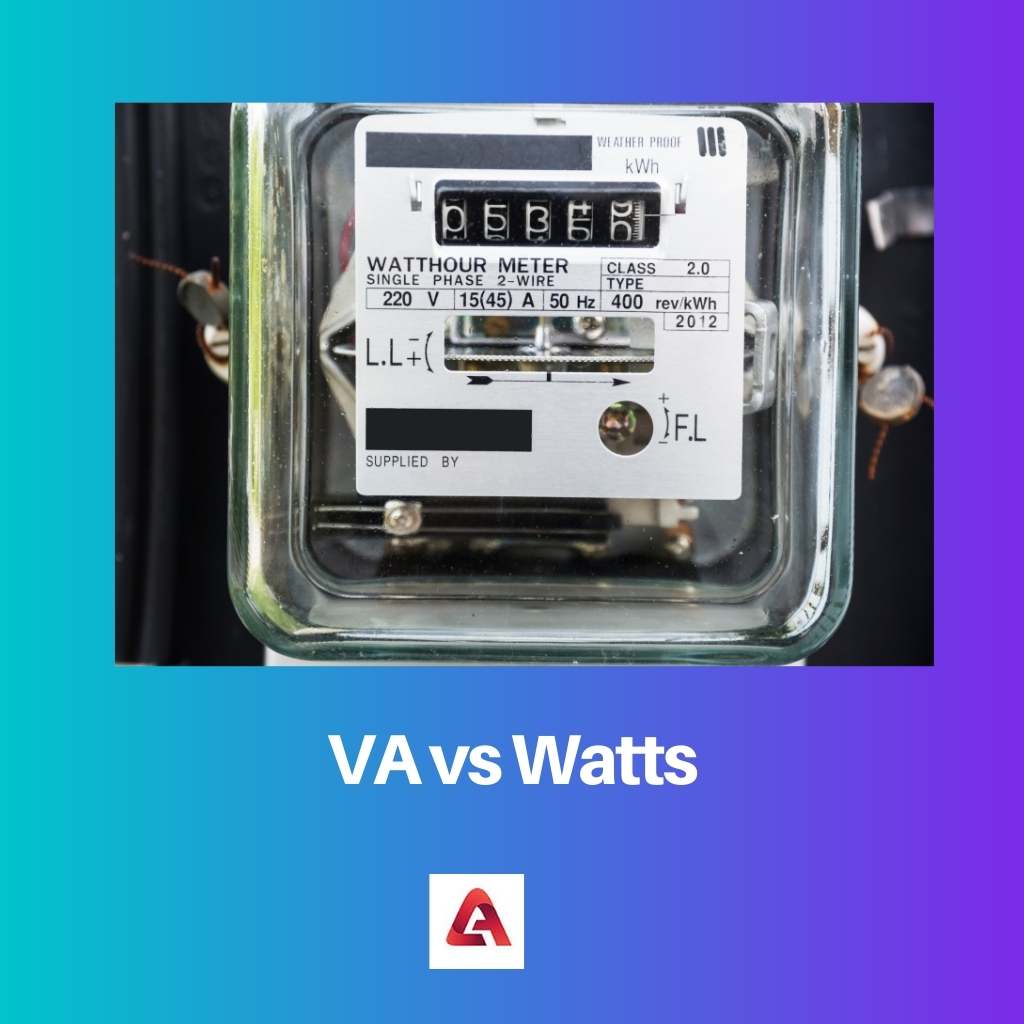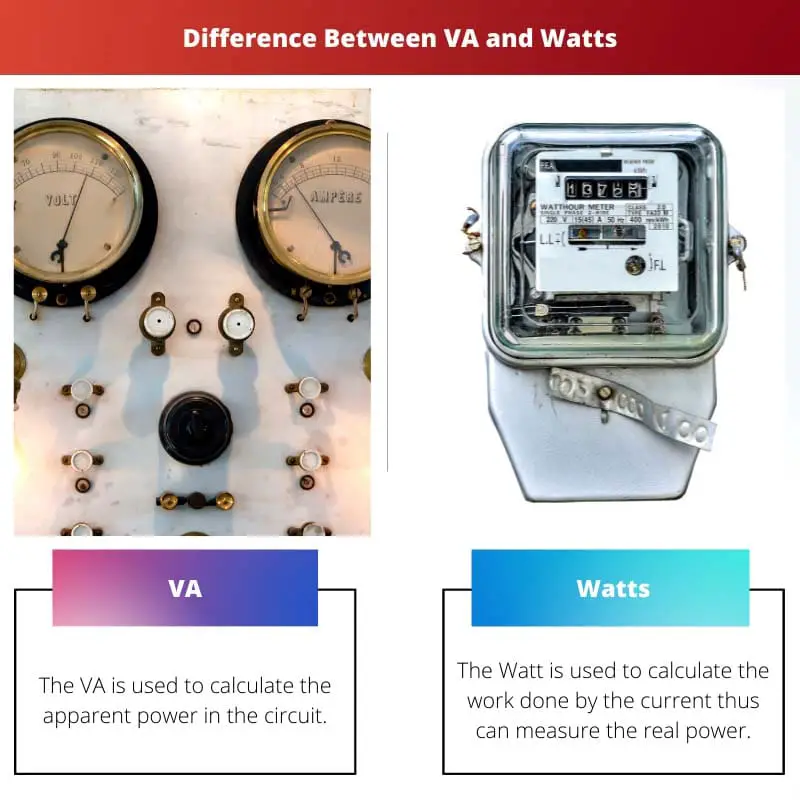The current is the flow of electrons from a point. The current is measured to determine the power of the electricity being supplied by the wires.
The measure of current can be measured in many unit systems. Two of them included are the VA and Watts.
The current, when being transferred on a large scale, is measured in the unit Kilo Watt Hour.
Key Takeaways
- Volt-amperes (VA) represent apparent power, while watts (W) indicate real power in electrical systems.
- VA measures the total power in an AC circuit, including both active and reactive power, whereas watts only account for the active power consumed by a device.
- Power factor, the ratio between real and apparent power, is essential to convert VA to watts or vice versa, which helps determine the efficiency of electrical systems.
VA vs Watts
The difference between VA and Watt is that VA refers to the apparent power, and Watt refers to actual power. The Watt can be calculated by adding all the current linearly, whereas the VA can not be measured by just adding the values. Many other factors, like heat loss and current loss during conduction, need to be measured.

The VA stands for the Volts Ampere. It is used as a unit of measure for the apparent current.
The absolute value of current can not be measured because of the other factors. Like during transportation, the current produces a heat effect therefore, there is a loss of power.
Other factors like loss of current during distribution or due to leakage can also be seen. Thus, the absolute current can not be measured.
The Watt is also the measure of the current. It is the value of the real current. The Watt is used to measure the work done by the current.
Therefore, the current can be added linearly as the loss of power is not considered when we are calculating the work done by the power. Thus, the absolute value of work done by the current can be measured.
Comparison Table
| Parameters of Comparison | VA | Watts |
|---|---|---|
| Full-Form | The VA stands for the Volt-Ampere | The Watt is itself a full form of the abbreviation “W”. |
| Definition | The VA is used to calculate the apparent power in the circuit. | The Watt is used to calculate the work done by the current thus can measure the real power. |
| Formula | The VA is the product of the Voltage and Current in the circuit. ( VA=V×I) | The Watt can be measured by the product of the voltage and current in the circuit. (W=V×I) |
| Alternate Current | The VA is applied to the Alternate current. | The Watt is applicable on the Alternate current circuit. |
| Direct Current | The VA is not feasible in the Direct Current circuit. | The Watt is also applicable on the Direct Current circuit. |
| Uses | The VA can be used to calculate the current of the product that can be conducted through it if we know the voltage. | The Watt is used to measure the amount of electricity spent in a house or company. It can provide an estimation of the bill too. |
What is VA?
The VA stands for Volt-Ampere. It is used to measure the apparent current in the circuit.
VA is greater than or equal to the Watt. The VA is significant in knowing the sizes of the wires to be used in the circuit.
The VA is used in the Direct current circuit. The apparent values of the direct current circuit are almost equal to the real power measured in the Watt.
The VA can be calculated if we know the RMS current and voltage of the product. The product of the Voltage of RMS and the Current of RMS is the value of the VA.
The VA in a circuit can not be added linearly and know the whole value as during transportation there is a loss of power or some amount is even lost as heat during conduction.
The VA can be used in a circuit to know the value of the current that the wire can transport. In some circuits, due to overload, the wires or the products are affected.
Therefore, the VA current is used to measure the load a circuit wire can afford and therefore maintain the current to avoid any mishap.

What is Watts?
The Watt is used to measure the work done by the power. It is the real value of the current in the circuit.
The Watt can be used to measure current in both AC and DC circuits. The Watt can be added linearly in the circuit as the heat loss or leakage is not included in the Watt.
The Watt is calculated if we know the circuit’s voltage and current. The product of the circuit’s voltage and current equals the circuit’s power in watts.
The 1W is equal to the 1J/s. If we are calculating the Power and considering it, the average current value needs to be considered, as the Instantaneous current is always changing.
The Watt is used to calculate the power in the AC and DC circuits. Thus, the Watt provides an estimation of the power that is being utilized by the company or in the home.
This includes all the appliances that are spending electricity. This provides an estimation of the bill to be paid.

Main Differences Between VA and Watts
- The VA is used to calculate the apparent current, and Watt is used to measure the real current value in the circuit.
- The VA is used in the AC, while the Watt is used in both AC and DC.
- VA is always greater than or equal to the Watt.
- The Watt can be measured by adding linearly in a circuit, but this does not apply to VA.
- The VA is used to measure the power consumed, while Watt is used to measure the work done by the current.

- https://iopscience.iop.org/article/10.1088/0022-3727/41/19/194002/meta
- https://link.springer.com/article/10.1007/BF00582392

The explanations provided for both VA and Watts are excellent. It gives a well-rounded understanding of apparent power and real power.
The explanation is really detailed and thorough, providing a strong understanding of VA and Watts: real power, apparent power, power factor, and the difference between VA and Watt.
I agree, the post effectively clarifies the confusion around these concepts. Very informative!
I found the comparison table very helpful in understanding the clear distinction between VA and Watts.
The post does a great job of explaining the fundamental differences and applications of VA and Watts. Really insightful.
This article is very well-researched and well-structured. I would love to see more on this topic.
It is true that the VA is applicable to both AC and DC circuits. The article has provided a good comparison of the two units.